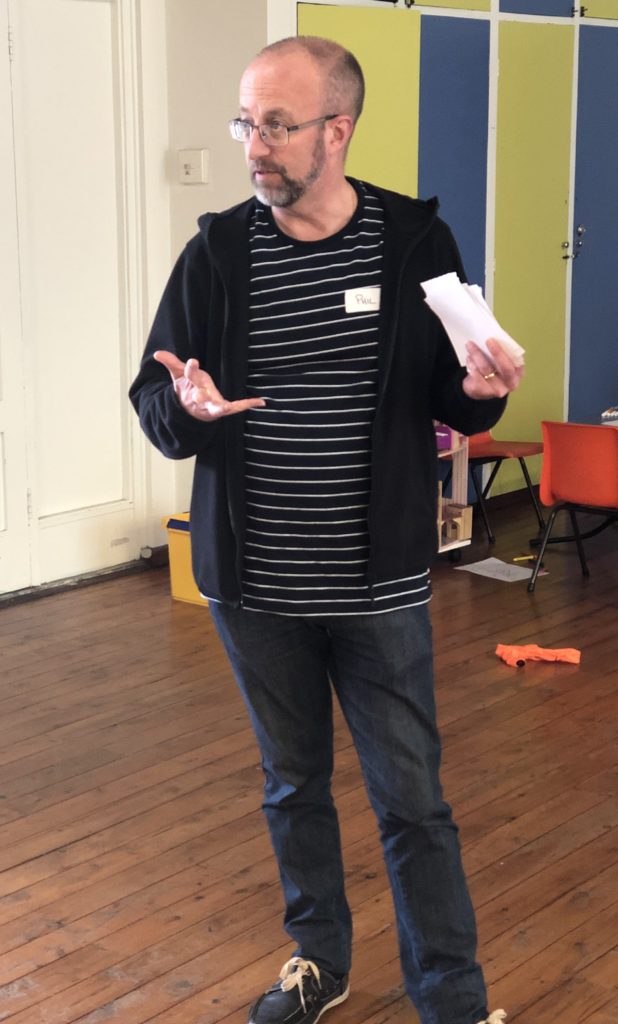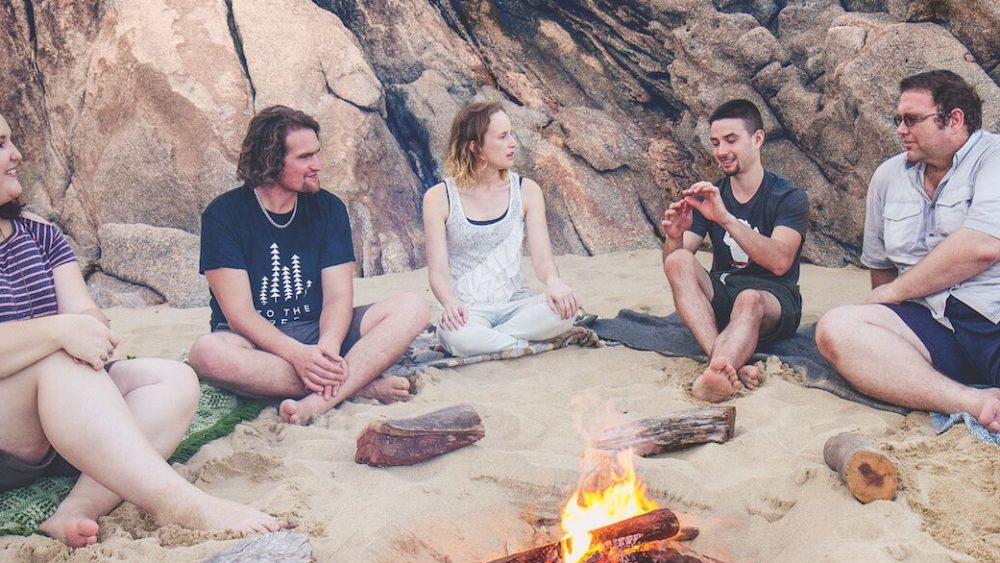Can I tell you a story? Every week at my Bible and English class at St Andrew’s Cathedral in Sydney, I have the chance to give a Bible message to a group of about 20 migrants, refugees and travellers.
I’m fine with the English part – there’s so many resources on the internet – but have trouble with the Bible story part of the two-hour English class. I’ve struggled to bring the stories to life or to bring people to Jesus.
Now, having completed a ‘Story the Bible’ workshop put on by Wycliffe Bible translators over the October long weekend, I feel excited and equipped. I feel sure I can engage this diverse group of people from Europe, the Middle East and Asia with the riches of God’s word, hopefully leading them to understand who Jesus is and to find their joy and salvation in him.
Along with eight others of all ages and backgrounds, over an intense 24 hours spread from Friday night to Monday afternoon, I learned how to craft a Bible story that is Simple, Accurate and Memorable – our key acronym, SAM! I also learned how to facilitate a discussion about it.
I had previously discovered the power of Bible storytelling when I told my ESL class the very simple story of the widow of Nain, whose only son is raised from the dead by Jesus (Luke 7:11-17).
They were completely captured and attentive, in contrast to times when we read a story and did a comprehension exercise. However, though their responses were relevant and good, I struggled to keep the discussion going.
Other workshop attendees were involved in mission to Muslims or Hindus and wanted to harness the power of storytelling to break down barriers to the Bible in these oral cultures.
It’s important to visualise the scene and tell what we see rather than trying to memorise the words.
Our first lesson on the Friday night highlighted the power of repetition. Our leader, Rob, told us the story of the Good Samaritan twice, then taught it to us line by line twice, then action by action in larger chunks. Then we told the story to each other in groups and finally a couple of people told the story again to the whole class.
By the end of the evening, we had heard the story 12 times, which meant we were confident in practising it that night with someone at home before the next session.
Another key insight from our first lesson was the power of imagination. It’s important to visualise the scene and relate what we see rather than trying to memorise the words. I was delighted to discover that I have a rather good memory, but even those who struggled to remember the words eventually learned the story and told it with expression – to their surprise and delight!
The Saturday sessions were devoted to learning how to craft a Bible story in pairs, with the aim of presenting a “panorama” of seven Bible stories at the two Sunday services of the church where our workshop was held. My partner, Lisa, thanked God for his kindness in giving us the relatively straightforward story of Jesus feeding the 5000. I felt sympathy for the pair who were given the Woman at the Well – a fabulous story but so much dialogue!
Our first step was to read the two versions of the Feeding the 5000 story in Mark and John’s gospels in a modern language version – the New Living Version and the CEV.
We decided to use the version in Mark’s Gospel as it was simpler and more contained.
The heart of the crafting process was drawing a storyboard of our narrative.
We took turns reading the passage to each other as the other partner closed her eyes and imagined the scenario. Then we wrote down the actions in the story step by step. The aim was to keep the story to less than three minutes, so we discussed how to simplify it. We considered if any historical details could be omitted and whether any Christian terminology needed to be changed, bearing in mind our SAM acronym.
In the end, we decided to keep the word ‘disciples’ rather than changing it to Jesus’ close friends.
The heart of the crafting process was drawing a storyboard of our narrative, taking turns to read each sentence while the other drew stick figures of the action on a piece of paper – a highly entertaining exercise! My favourite picture was of people with full bellies and happy smiles after being fed! Then after telling each other the story using the sequence of drawings, we put the storyboard away and practised it with dramatic gestures and expressions.

Phil practises telling the story of the sinful woman who wept over Jesus’ feet.
To help us remember, we tried to section the action into groups of three. Then we polished the story by putting as much of the description as possible into direct speech. For example, instead of saying “Jesus wanted to take his disciples away to a quiet place where they could be alone and rest,” we said: “Jesus said: ‘I want to take you away to a quiet place where we can be alone and you can rest.’” This makes the story more immediate. You can even take out “Jesus said” by switching the way you are facing to indicate a change in speaker.
As we polished the story, we were powerfully struck by how compassionate Jesus was, first taking pity on his disciples and wanting to give them a rest, and then having pity on the crowd – caring for them as a shepherd cares for his sheep. Then we saw how he delighted to involve his disciples in his miracle when he didn’t really need to.
Thus encouraged, we presented our story to the whole class, who gave feedback on what could be improved, such as using hand gestures to show “five loaves and two fish”. By the time it came to present my story at the 10am service on Sunday morning, I estimate that I had told it at least eight times and heard it from my partner another eight times. We weren’t word perfect by any means, but neither did we dry up!
I ended up naturally breaking into laughter every time I said that “Jesus fed 5000 men that day – plus their families!” because the reality of it was so amazing!
The Holy Spirit must have gone before us as we presented in two teams, one at the 8.30am service and one at 10am, because everyone did their best rendition – and the people in the congregations loved the experience. Hearing seven stories in a chronological “panorama” really highlighted the extraordinary height and depth of Jesus’ power, compassion and sacrificial love for the lost. Many people commented afterwards that they would never be able to do what we did. But they really could – with the tools we were taught in this workshop.
By the end of the weekend I had learned three stories by heart, heard many more – including three-minute versions of the exodus and Ruth! – convincing me that this is a powerful way of telling the gospel that grips the heart and mind of any hearer, no matter where they stand in relation to Christ.
To help us remember, we tried to section the action into groups of three.
But possibly the most helpful part of the weekend for me was understanding how to facilitate a discussion after indulging my show-off side in telling the story.
As someone who feels inadequate in explaining the Bible, I really appreciated being given a set of five questions – “What do you learn about God or Jesus in this story?”; “What do you learn about people/certain individuals in this story?”; What do you like about this story?” “What are some things people might not like about this story?” and “If this story is true, how does it change your life?”
It’s counter-intuitive just to paraphrase their answer and say “thank you”, then move on to the next person.
The best thing of all was the technique of not commenting on people’s answers but just reflecting back their comments and saying “thank you.” This takes a bit of discipline as our natural response is to say “Good point” or “That’s true” or “Yes, but …” It’s counter-intuitive just to paraphrase their answer and say “thank you”, then move on to the next person.
As a way of modelling how to be patient and wait for the deeper answers to come, we were asked why it’s important to say thank you. We took about 15 minutes to come up with four columns of ideas, which ranged from a simple “It’s polite” to “It encourages people to be more thoughtful in what they say because they know the facilitator needs to be able to paraphrase their comment.”
The upshot of this is that I don’t have to be the expert! Hooray! Anyone can facilitate the discussion – even a non-believer! And you don’t even have to correct wrong answers. Since people are given space to share what they get out of the story, over time they will have their ideas shaped by other people’s answers and other stories they will hear. This way they will want to keep coming back for more!
Now I’m looking forward to being able to disciple my English learners with many stories from the Bible over the next months! And because everyone loves to hear a story, I also have a non-confronting way of telling people the gospel. I’ve already tried it on my Hindu barista and sparked a conversation that I hope will continue. Stay tuned!
The next Storying the Bible workshop is in Maleny, in Queensland, November 21-24. For further information, contact Francois Van Der Walt on (0419) 623 397. There will also be one in Sheffield, Tasmania, in April 2020.
For information about hosting a Story the Bible workshop for your church or ministry, contact [email protected]



